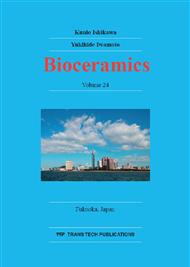p.147
p.153
p.157
p.161
p.167
p.173
p.178
p.183
p.187
Comparative Study on Bioresorbability of Chelate-Setting Cements with Various Calcium-Phosphate Phase Using Rabbit Model
Abstract:
We have developed novel calcium-phosphate cements (CPCs) based on the chelate-setting mechanism of inositol phosphate (IP6) using hydroxyapatite (HAp), β-tricalcium phosphate (β-TCP) and α-TCP as starting materials. These cements (IP6-HAp, IP6-β-TCP and IP6-α-TCP cements) have different bioresorbability due to the chemical composition of starting materials. In the present study, biocompatibility and bioresorbability of the above three cements and commercially available cement (Biopex®-R) was histologically evaluated in vivo using rabbit model for 4, 8, and 24 weeks, in addition to their dissolution in vitro. The dissolution of these cements increased in the order of IP6-HAp, IP6-β-TCP and IP6-α-TCP cements. The newly-formed bones were directly in contact with both the IP6-HAp and Biopex®-R cement specimens. As for the IP6-β-TCP and IP6-α-TCP cements, newly-formed bones were formed time-dependently slightly apart from the cement specimens. Resorption rate for Biopex®-R, IP6-HAp, IP6-β-TCP, and IP6-α-TCP cements after 24 weeks implantation were of 7.2, 5.0, 13.7, and 16.2%, respectively, compared to original cements. The present chelate-setting cements with different bioresorbability are promising candidates for application as the novel CPCs.
Info:
Periodical:
Pages:
167-172
Citation:
Online since:
November 2012
Price:
Сopyright:
© 2013 Trans Tech Publications Ltd. All Rights Reserved
Share:
Citation:


